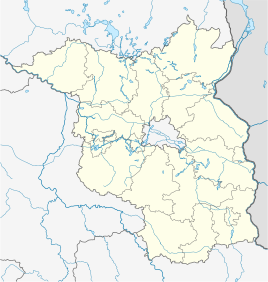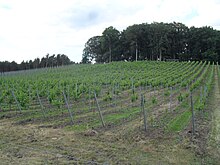Jerischke
|
Jerischke
Community Neisse Malxetal
Coordinates: 51 ° 36 ′ 58 ″ N , 14 ° 42 ′ 57 ″ E
|
||
|---|---|---|
| Height : | 119 m above sea level NN | |
| Area : | 33.83 km² | |
| Residents : | 149 (Jun 30, 2020) | |
| Population density : | 4 inhabitants / km² | |
| Incorporation : | December 31, 2001 | |
| Postal code : | 03159 | |
| Area code : | 035600 | |
|
Location of Jerischke in Brandenburg |
||
Jerischke ( Jarješk in Lower Sorbian ) is a district of the municipality of Neisse-Malxetal in the Brandenburg district of Spree-Neisse . The place was incorporated on December 31, 2001 and was previously an independent municipality. Jerischke belongs to the Döbern-Land office and is the largest in terms of area and the second smallest in terms of population in the municipality of Neisse-Malxetal.
Location and accessibility
Jerischke is located in the Lower Lusatia and Muskau folds , around seven kilometers as the crow flies north of Bad Muskau , eight kilometers as the crow flies east of the city center of Döbern and three kilometers from the border with Poland . The district borders in the north on Klein Bademeusel , in the east on the Polish villages of Olszyna , Bukowina , Siedlec , Buczyny and Żarki Wielkie , in the south on Köbeln , in the southwest on Jämlitz and in the northwest on Preschen . In addition to the main town, the district of Jerischke also includes the districts of Bahren , Pusack and Zelz as well as the Teichhäuser residential area .
To the south of the village is the Zschornoer Wald . Between 1972 and 1990 the bombing and shooting range 31 Jerischke of the Preschen airfield was located in this area , which means that today there is a high level of ammunition and duds in this area. Southeast of the suburb of Zelz is the easternmost point of Brandenburg on the Lausitzer Neisse .
Jerischke is located on Kreisstraße 7101 between Döbern and Klein Bademeusel. The federal highway 115 ( Forst - Görlitz ) is seven kilometers to the west and the junction Bademeusel on the federal highway 15 (Lübbenau-Forst) around nine kilometers northeast of the village. The parts of Bahren, Pusack and Zelz are on the Neisse-Oder-Radweg .
history
The place was first mentioned in documents in 1532 with the spelling Jerischkow . The place name comes from Sorbian and means "settlement near a small ditch". Jerischke used to be a vassal village of the Forst rule and at the time it was first mentioned it belonged to the Bohemian crown lands . In terms of church, Jerischke has always been assigned to the Preschen parish. With the Peace of Prague in 1635 Jerischke came to the Electorate of Saxony . In 1708 there were seven gardeners and five Büdner in Jerischke . At the end of the 18th century there was a village school in Jerischke.
At the beginning of the 19th century Jerischke had 145 inhabitants and an estimate of 1200 guilders. In 1806 the Electorate of Saxony was elevated to a kingdom . After the partition of Saxony decided at the Congress of Vienna , Lower Lusatia, and thus also the village of Jerischke, was surrendered to the Kingdom of Prussia . The place was assigned to the Frankfurt administrative district of the Brandenburg province . In the municipal reform carried out in 1816, Jerischke came to the Sorau district . In the Topografisch statistical overview of the district of Frankfurt , built in 1844 is a village with a Jerischke Vorwerk recorded, a colony, a Teerofen and a sheep; the place had 210 inhabitants in 42 buildings. By 1864 the population rose to 236, and there is also a brick factory there. At the census of December 1, 1871, the rural community Jerischke had 159 inhabitants in 34 families. Of the inhabitants, 80 were men and 79 women; 39 residents were children under ten years of age. In the Jerischke manor district, 42 residents - 21 men and women each - lived in seven families and a single household at the same time. 12 residents were younger than ten years. One resident of the manor was Catholic, all other residents (both in the rural community and in the manor) were Evangelical Lutheran.
In 1874 the rural community and the Jerischke manor district joined the Preschen district . The school from Jerischke was closed before 1890, in that year the children of the village attended the school in Preschen. After the rural community of Jerischke tried again to spin off the Preschen school association, a school was inaugurated on October 16, 1906. At the census on December 1, 1910, the rural community had 136 and the manor district 35 inhabitants. In 1927 Jerischke and Teichhäuser were connected to the power grid. On September 30, 1928, the Jerischke manor district was dissolved and incorporated into the rural community. On April 16, 1945, the first day of the Battle of Berlin , the Red Army occupied numerous places west of the Neisse, including Jerischke. After the end of the war and the determination of the Oder-Neisse border , the district of Pusack was reclassified from the community of Groß Särchen , located on both sides of the Lausitz Neisse, to Jerischke. The county and the county Dash Sorau were dissolved and the community Jerischke changed in the Soviet zone of occupation in the district Spremberg . Due to the accommodation of refugees from the former German eastern areas in the manor house of Jerischke, the population rose briefly to almost 300, but then fell again.
The GDR was founded on October 7, 1949 , during the territorial reform on July 25, 1952, the states were dissolved and 14 districts were created. Jerischke was assigned to the newly formed forest district in the Cottbus district . In the early 1960s, the Jerischke school was converted into a polytechnic high school . In 1973 the school was closed due to a lack of demand, and the local children have been attending schools in Friedrichshain , Döbern and Forst since then . The harvest kindergarten in Jerischke was also closed in 1973 . On May 1, 1973, the neighboring community to the east of Zelz-Bahren was dissolved and its suburbs and Bahren and Zelz were incorporated into the Jerischke community. After reunification , Jerischke was initially in the Forst district in Brandenburg, where in 1992 it merged with several other municipalities to form the Döbern-Land office .
The district of Forst was opened on December 6, 1993 during a district reform in the new Spree-Neisse district . On December 31, 2001, the Jerischke community merged with Groß Kölzig, Klein Kölzig and Preschen from the Döbern-Land district and the Jocksdorf community from the Hornow / Simmersdorf district to form the new community of Neisse-Malxetal . The previous districts of Bahren, Pusack and Zelz were downgraded to parts of the municipality. At the time of the dissolution, the community of Jerischke had 169 inhabitants, the last mayor was Wilfried Koinzer.
Population development
|
|
|
|
|
Territory of the respective year; from 1946 with pusack, from 1981 with stretchers, pusack and zelz
Attractions
In Jerischke there is a manor house from the 18th century with a park attached to the property.
Vineyard
On the outskirts of the village there is a two-hectare vineyard Marbach's Wolfshügel . The grape varieties Regent, Pinot Noir, Riesling and Johanniter are grown.
Web links
literature
- The Berlin Wine Guide 2009 , Verlag Medienbüro Norbert Pobbig ISBN 978-3-9813516-0-6
Individual evidence
- ↑ Facts and Figures. In: amt-doebern-land.de. Office Döbern-Land , accessed on August 22, 2020 .
- ↑ "Jarješk" entry in the Lower Sorbian place names database on dolnoserbski.de
- ↑ Matthias Matern: Natural heritage given away. In: Potsdam's latest news . June 18, 2012, accessed August 16, 2017 .
- ↑ Bomb throwing and ground shooting range 31. Accessed January 19, 2017 .
- ↑ Reinhard E. Fischer : The place names of the states of Brandenburg and Berlin: age - origin - meaning . be.bra Wissenschaft, 2005, p. 83 . ( on Google Books )
- ↑ Johann George Schreiber : Geographical description of the Lower Lusatia and its neighboring Oerter in Silesia . 1748. p. 25
- ↑ Local history and first mention. In: chronik.jerischke.eu , accessed on August 22, 2020.
- ↑ August Schumann : Complete state, postal and newspaper encyclopedia from Saxony, Vol. 4. Herlegrün to Königstein. Gebr. Schumann, Zwickau 1817, p. 310 .
- ↑ Topographical-statistical overview of the government district of Frankfurt ad O. Gustav Harnecker's bookstore, Frankfurt a. Cit. 1844, p. 194 .
- ↑ Royal Statistical Bureau: The communities and manor districts of the Prussian state and their population . Part II: Province of Brandenburg , Berlin 1873, p. 226f., No. 67 ( online ), and p. 232f., No. 188 ( online ).
- ^ Jerischke elementary school. In: chronik.jerischke.eu , accessed on August 22, 2020.
- ↑ lr-online.de April 19, 2007: Fierce fighting raged near the Neisse in April 1945
- ↑ see also the report of a contemporary witness
- ↑ Historical municipality register of the state of Brandenburg 1875 to 2005. (PDF; 331 KB) District Spree-Neisse. State Office for Data Processing and Statistics State of Brandenburg, December 2006, accessed on August 22, 2020 .
- ^ [1] Newspaper report on the first vintage in a long time, accessed in Lausitzer Rundschau on April 17, 2015
- ^ [2] Network Viticulture in the State of Brandenburg Jerischke, accessed on April 17, 2015
- ↑ [3] Information on the vineyard, accessed on April 21, 2015

